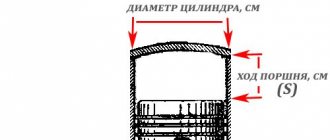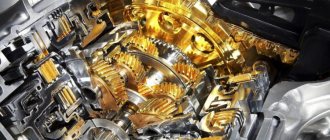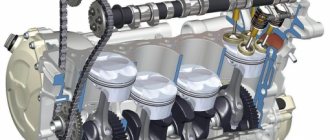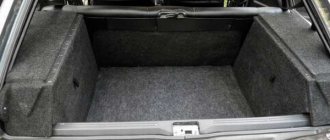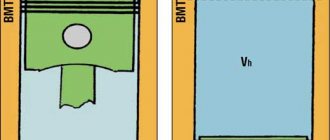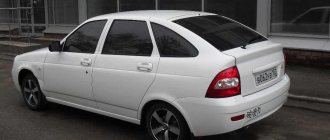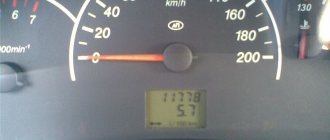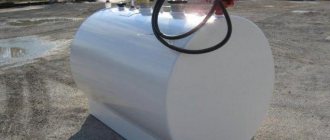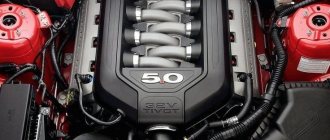The very first assembly of an internal combustion engine (ICE) dates back to 1885 and was carried out by German engineer Karl Benz. Since then, engineers have been constantly trying to improve the dynamics of engines. And the expression “engine displacement” is always heard, but not everyone knows what engine displacement is in reality and what parameters it consists of.
Engine volume is a design parameter of an internal combustion engine that determines its power.
In many countries, car taxation is determined by the displacement of their engines. For example, in Japan, owners of Kei Cars, which belong to the class of small cars and have an engine capacity of 0.66 cm cubic, do not pay road tax. In some countries around the world, tax legislation is structured so that the larger the engine displacement, the higher the road tax.
As for Russia, here the amount of road tax is determined by the number of horsepower, although these two parameters are completely interrelated. From all of the above, we can conclude that engine size is an indicator of the car’s power, as well as the solvency of its owner.
One of the promising vectors for the development of internal combustion engines design is the creation of engines with variable displacement, which is achieved by using a system for automatically shutting off several cylinders in partial engine load mode.
This technology is already used on some new American-made SUVs, thanks to which it is possible to save about 20% of the fuel mixture.
Currently, in the experimental stage, special engines with mechanical changes in the piston stroke are used. But internal combustion engines with variable displacement have already been used for some time as laboratory equipment, for example, when determining the octane number of gasoline using the “engine method”.
How to find out engine size by VIN code? Decoding the VIN code
You can also find out the engine size by the VIN code. You can see it at the bottom of the driver's door arch, naturally, after opening it first. It is also indicated under the rear seat, under the windshield and in the upper left part of the instrument panel (in this case, the code must be looked at from outside the car).
The last method listed is the most reliable. Since the VIN code is indicated on all cars that were produced starting from about 1980. It consists of seventeen characters, among which the Latin letters I, O and Q are not used due to their similarity with the numbers 1 and 0.
- The first three characters indicate the car manufacturer's index. (The first is the geographic area code, the second is the country code in that geographic area, and the third is the manufacturer's symbol).
- The fourth to eighth digits inform about the main technical parameters of the car: model, engine type and size, body type, and so on.
- The ninth character is the check digit. It is needed so that the authenticity of the VIN code can be determined. With its help, you can find out whether the car is listed as stolen.
- The twelfth to seventeenth characters are the car body number.
Calculator for calculating the cylinder displacement of a car engine
The formula for calculating a cylinder has been known since school curriculum - the volume is equal to the product of the area of the base and the height. And in order to calculate the engine volume of a car or motorcycle, you also need to use these multipliers. The working volume of any engine cylinder is calculated as follows:
How to find out engine size
Note that the full volume and the working volume are different, since the piston has bulges and recesses for the valves and also includes the volume of the combustion chamber. Therefore, you should not confuse these two concepts. And to calculate the real (total) volume of the cylinder, you need to sum up the volume of the chamber and the working volume.
Thus, if, for example, you find that the volume is 1598 cm³, then in liters it will be designated as 1.6 liters, and if the number is 2429 cm³, then 2.4 liters.
Why do you need to check engine size?
Volume calculation
Liquid displacement method
The volume of an object can be calculated using the fluid displacement method. To do this, it is lowered into a liquid of a known volume, a new volume is geometrically calculated or measured, and the difference between these two quantities is the volume of the object being measured. For example, if when you lower an object into a cup with one liter of water, the volume of the liquid increases to two liters, then the volume of the object is one liter. In this way, you can only calculate the volume of objects that do not absorb liquid.
What is engine displacement and how to calculate it
The very first assembly of an internal combustion engine (ICE) dates back to 1885 and was carried out by German engineer Karl Benz. Since then, engineers have been constantly trying to improve the dynamics of engines. And the expression “engine displacement” is always heard, but not everyone knows what engine displacement is in reality and what parameters it consists of. In many countries, car taxation is determined by the displacement of their engines. For example, in Japan, owners of Kei Cars, which belong to the class of small cars and have an engine capacity of 0.66 cm cubic, do not pay road tax. In some countries around the world, tax legislation is structured so that the larger the engine displacement, the higher the road tax. As for Russia, here the amount of road tax is determined by the number of horsepower, although these two parameters are completely interrelated. From all of the above, we can conclude that engine size is an indicator of the car’s power, as well as the solvency of its owner.
This technology is already used on some new American-made SUVs, thanks to which it is possible to save about 20% of the fuel mixture. Currently, in the experimental stage, special engines with mechanical changes in the piston stroke are used. But internal combustion engines with variable displacement have already been used for some time as laboratory equipment, for example, when determining the octane number of gasoline using the “engine method”.
Engine displacement characteristics
The working volume of all types of engines is usually measured in cubic centimeters, or liters. It is according to these parameters that machines can be divided into the following categories:
- minicars (no more than 1.1 liters);
- small cars (from 1.2 to 1.7 liters);
- medium volume (from 1.8 to 3.5 liters);
- large-capacity (from 3.6 or more liters).
But along with fuel consumption, the power of the car also increases, because more fuel will produce a greater amount of released energy.
The disadvantages of large-capacity cars, in addition to fuel consumption, include their higher cost. So, it is logical to assume that much more materials will be required for its manufacture, and the requirements for the quality of manufactured parts will, accordingly, be much higher.
How to calculate engine size
- For example, if a car has an inline four-cylinder engine, and the volume of each individual cylinder is 499 cubic centimeters, we should multiply this number by four.
- As a result, we will get a value that determines the displacement, in our case it is 1996, then we round it to the nearest whole value. In our case it is 2000, then we divide this value by 1000, and this means that this engine will have a volume of two liters.
The principle of operation of the internal combustion engine
Operating principle of an internal combustion engine:
- The combustion chamber of the power unit is filled with a fuel mixture (gasoline with air). The chamber is designed so that it has a movable element (piston).
- Then, using a special device called a “spark plug,” the fuel mixture ignites.
- The energy released as a result of the “explosion” pushes the piston down, which in turn transmits the movement to the crankshaft, which, through various gearboxes, begins to spin the wheels.
How to increase engine size
As a result, how can you increase engine power yourself? Typically, there are several ways to solve this problem. It all depends on how much you want to increase the power output of the engine and of course on the size of your wallet:
The simplest and cheapest option is simply boring the cylinder block to increase the combustion chamber. In this case, your costs will only be associated with the purchase of new pistons of larger diameter. A more expensive option is to replace the “original” crankshaft with a shaft with a larger crank radius. Well, since the diameter of the connecting rods will increase, you will have to change the entire piston group. After this procedure, the stroke of the pistons will increase, and, accordingly, the displacement of the power unit will become larger.
What method to use to increase the power of a car is a personal matter for everyone. But it is worth remembering that boosting the engine at home is simply unrealistic. This requires special equipment, and most importantly, highly qualified specialists. So, if you still decide to take such a step, you have a direct route to a tuning agency.
Tip 2: How to increase engine capacity
Car engines of the Volzhsky Automobile Plant are produced in small volumes, but, as is well known, the displacement of the engine can be triumphantly increased. As a result, the power and dynamics of the car subsequently increases, which pushes followers of car control in the sports genre to implement engine .
You will need
- – new piston group, – newest crankshaft. - motorist assistance.
Instructions
1. Motorists, if you contact them for advice, can offer several options for increasing engine ; the choice of one of them depends on the client’s wishes, as well as on how much the owner is willing to spend on engine .
2. A primitive and low-cost option provides for trivial boring of the cylinder block liners for the installation of larger diameter pistons, which will result in a slight, but still increase in engine displacement. Using this method of boosting the engine will only entail costs associated with obtaining a new piston group.
3. Along with this, there is another option for increasing engine , one that involves replacing the standard crankshaft with another one that has an increased crank radius. Accordingly, a crankshaft of a special design cannot be installed in the engine complete with ordinary pistons; therefore, this method of boosting also involves obtaining a special piston group. As a result of similar engine tuning, the piston stroke increases, which significantly increases the volume of the entire cylinder in particular, and increases the engine in total.
4. Which of the 2 options for increasing engine is preferred, the entire motorist decides for himself. But do not forget that engine is carried out only in a specialized workshop by highly qualified experts who have high-precision instruments and the necessary equipment at their disposal, and who will help the owner decide on the choice of a specific option for increasing engine volume.
Video on the topic
Note! Occasionally, to increase engine power, metamorphoses are made to the gas distribution mechanism, which involves the reconstruction of the cylinder head with the replacement of the camshaft and valves. Explore this option for boosting the engine. Who knows, maybe it will be even more effective in terms of detecting the hidden probabilities of the power plant.
How to find out the engine size of a car
Types of engines
Diesels are more reliable due to the fact that they operate without electronic devices, and even in the event of a breakdown, repairing such engines will cost much less than gasoline ones.
Powertrain differences
A powerful car will serve you for a long time, and if used correctly, it will also be a reliable assistant, because the engine does not suffer from overload and can be fully operated with the air conditioning and other electronic systems turned on.
- Engines with a volume of 0.8 to 1 liter. They are mainly installed on vehicles for transporting goods due to their low power. They consume about 5 liters per 100 kilometers.
- Units with a volume of 1.2 to 1.8 liters are quite suitable for everyday driving; they have low fuel consumption, around 5–10 liters per 100 kilometers.
- The golden mean is 1.8–2.5 liters. Low tax, reasonable consumption and confident acceleration - both in the city and on the highway.
- Engines with a volume above 3–4.5 liters are installed on expensive foreign cars.
- Cars with 5-liter units belong to luxury categories and are subject to increased taxes.
Determining engine size
Now let’s talk about how to find out the displacement of a car unit. There are several ways. You can look at the volume in the car’s technical passport, but this method is not entirely suitable when buying a used car. Perhaps the engine configuration was changed or modernized. The actual value can only be found on the cylinder block.
You can also determine the engine displacement by the VIN code. You should look for it under the rear seat, under the windshield, or at the bottom of the driver's door arch. This code consists of seventeen characters.
Pros and cons of large-displacement engines
Flaws:
- original price of the car;
- high fuel consumption;
- high maintenance costs (more oil, more antifreeze, etc.);
- high costs for major repairs;
- high taxes and customs duties (if the car is imported from abroad).
Advantages:
- high vehicle power;
- long service life of the engine itself;
- riding comfort;
- you have to change gears less often with a manual transmission;
- safety when overtaking;
- Such engines warm up faster and better during cold periods.
Large naturally aspirated gasoline power units are less demanding on fuel quality than small-volume turbocharged units.
A few words about turbocharged and naturally aspirated engines
It is worth understanding that a conventional naturally aspirated internal combustion engine is more reliable. A 1.8-2 liter petrol turbo engine with a power of 200 hp, even with the highest quality maintenance, will require a major overhaul at 180-230 thousand km. But a naturally aspirated 3.5-liter internal combustion engine, which has the same power (or slightly higher), easily lasts 350 thousand km before the first major repair.
Calculating engine cylinder volume: tips, explanations, formulas
Calculation of cylinder volume
The concept of cylinder displacement
Detonation can be identified by a sharp knocking sound, a decrease in engine power and thick black smoke from the exhaust pipe. Automotive designers are constantly looking for ways to eliminate fuel detonation when increasing the compression ratio. The compression level determines the need to use a specific type of fuel.
Variable displacement
Online calculator
The volume of a cylinder can be calculated using:
- base radius and height, with the height equal to the piston stroke;
- base area and height.
But there are also more complex calculators with an expanded range of functions. They allow you to calculate not only engine volume, but also the compression ratio. For calculations, the values of the following parameters are required:
- connecting rod length;
- piston stroke;
- piston under-return;
- cylinder diameter;
- piston chamber volume;
- thickness and diameter of the gasket;
- chamber volume in the cylinder head;
- number of cylinders.
Before calculating the volume of a cylinder or the entire engine, or calculating the compression level, you should clarify and record all of the above parameters. Beginners may have difficulty with this, so they will have to be persistent.
Engine size - how it works and what it is and what it affects
The engine is the heart of the car, so when choosing a car, buyers often pay attention to one important factor - its volume. However, few people have any idea what engine displacement is and what it affects.
Let's start with a definition - the engine displacement is the sum of all the volumes of the car's cylinders, where the piston volume is the product of the piston area and its stroke, and the piston stroke is the distance from top dead center to bottom dead center. In simple terms, cylinder volume is the volume of the combustion chamber, where ignition and combustion of fuel occurs. Engine volume is calculated in cubic centimeters or liters. One liter is 1000 cubic centimeters. Depending on the volume, cars are divided into mini-displacement - up to 1.1 liters, small-displacement - 1.2-1.7 liters, medium-displacement - 1.8-3.5 liters and large-displacement - over 3.5 liters. This division is mainly used for cars with gasoline engines.
How does a car engine work?
On the reverse side, the piston is attached to the crankshaft, through which the pushing force is transmitted to the wheel axle, which sets the car in motion. The more fuel is burned, the stronger the shock will be.
Accordingly, a large combustion chamber will provide more engine power than a small one. This is, of course, a very simplified explanation; in practice, power is influenced by many factors.
What is engine displacement?
How cars are divided into classes based on engine size
The installation of a particular motor on a specific model directly depends on what characteristics the car should demonstrate (acceleration dynamics, torque, maximum speed, etc.).
Much higher costs are required compared to the manufacture of a three-cylinder engine with a volume of 0.8 liters.
What does engine size affect?
- Firstly, gasoline consumption. The larger the cylinder volume, the more fuel is needed to ignite it with maximum efficiency, and accordingly, consumption increases. However, this minus turns into an equally tangible plus. The larger the engine displacement, the greater the engine power, since more gasoline releases more energy.
- Secondly, as already noted, the larger the volume, the greater the power, that is, a car with a larger engine will accelerate faster, be able to carry heavier loads and more passengers
Their consumption in city traffic will be minimal compared to other cars, but, in turn, such cars are not suitable for long journeys, since at speeds over 100 km/h they clearly do not have enough power.
Increase in engine displacement
For this reason, during deep tuning of a car engine, it is better to immediately change the engine, that is, install another engine with an initially large displacement, which can then be additionally bored to the second or final repair size.
What is engine displacement
An internal combustion heat engine is an impressive complex of various mechanisms, systems and additional attachments, forming a complex engineering solution. The general principle of operation of an internal combustion engine involves supplying fuel and air to a special closed chamber, where the resulting fuel-air mixture ignites.
As a result of fuel combustion, energy is released, which pushes the piston located in the engine cylinder. The piston moves, the crankshaft converts the reciprocating motion of the piston into rotational motion, which allows the crankshaft to rotate. Next, the engine torque is transmitted to the transmission and then to the drive wheels of the car.
This process is constantly repeated after starting the engine, that is, the engine is running all the time, provided that the components are supplied and the fuel mixture is efficiently burned in the working chamber. This chamber is called the combustion chamber. The volume of the combustion chamber (also known as the working volume) is the product of the cross-sectional area of the cylinder and the length of the piston stroke from BDC to TDC (top and bottom dead center of the piston stroke). The physical volume of the combustion chamber is the working volume of the engine in gasoline and diesel cars, motorcycles and other types of land, air or water transport, agricultural machinery, as well as other mechanisms and devices using internal combustion engines.
Please note that if the engine has several cylinders, then the volume of the combustion chamber in each of them must be summed up with the others. In other words, the working volume of a multi-cylinder engine is the sum of the volume of the combustion chambers of all cylinders of such an engine. The total volume of all engine cylinders is usually expressed in liters. The working volume of the combustion chamber is indicated in cubic centimeters.
Let's look at this statement using the example of a widely used four-cylinder 2.0-liter internal combustion engine. We will not give exact figures, but simply imagine that each of the combustion chambers has a working volume of 498 cubic centimeters. Since the engine has 4 cylinders, we need to add up the volumes of all cylinders. The result is 1992 cm³. If we talk about internal combustion engines, then to determine the volume, rounding to whole numbers has become the generally accepted standard, and this happens upward. Thus, an engine with the total volume of all combustion chambers, which is actually equal to 1992 cm³, is an engine with a displacement of 2 liters, that is, a two-liter engine.
What makes up the useful displacement of an engine?
The engine, or rather its block, consists of several cylinders. Most often there are four of them, less often - six or eight, and in large SUVs and premium cars there can be ten or twelve. Sometimes there are engines with three or five cylinders.
The sum of the volumes of these cylinders is the working volume of the engine. In turn, the volume of each cylinder (more precisely, the volume of the combustion chamber of the cylinder) is the volume of space between the extreme positions of the piston (bottom and top dead centers). The location of the cylinders does not matter.
The volume of a cylinder is very rarely a multiple of an integer, usually it is 0.398 l, or 0.579 l, etc. Because of this, the total engine volume is also almost never a multiple of an integer, and engines of the usual 1.6 liter capacity are actually an engine with a volume of 1,598 liters, two-liter ones - 1,988 liters, etc.
What is a milliliter?
You may be interested in: Alsace-Lorraine - the “imperial land” of the German Empire: history, administrative center, government structure
There are many units for measuring volume: gallon, barrel, pint, but the most common is the liter. Today, one liter is equal to one cubic decimeter or 0.001 cubic meters. Interestingly, before this it was defined as one kilogram of distilled water at normal pressure, but later this system was abandoned, since different liquids at different pressures have different masses, and, accordingly, different volumes.
Fuel volume and consumption
The combustion chamber is a closed space of a cylinder, on one side of which there is a stationary block with valves, on the other there is a movable piston. A mixture of fuel and air enters the cylinder through the valves and ignites at the right moment, pushing the piston. The energy resulting from the combustion of the mixture is transferred from the piston to the crankshaft and its flywheel, then through the transmission to the wheels. ?? This happens several thousand times a minute.
It would seem logical to assume a direct relationship between fuel consumption and engine power and its volume - the more fuel-air mixture can be pumped into the cylinders, the more powerful the engine can be obtained. In the last century this was approximately the case.
Today is the age of modern technology, and it should not be surprising that some two-liter engines have lower fuel consumption than some 1.5-liter engines. Of course, the relationship between volume and flow with power remains, but this direct relationship is now influenced by many other factors.
For example, with the same volume of four cylinders, a 16-valve engine will be more powerful and more economical than an 8-valve engine due to a more optimal process of pumping the fuel-air mixture and removing exhaust gases.
In turn, an injection engine will be noticeably more powerful and more economical than a carburetor engine, because the fuel combustion processes in the injector are controlled electronically.
Also, the consumption of two engines of the same volume can vary greatly depending on the settings of the injection system, the presence of various systems that reduce engine emissions and the presence of a number of other indicators, including the type of transmission and the driving style of a particular driver.
Safety of operation of a powerful and voluminous power unit
The current trend towards reducing engine displacement is clear. The more cubic meters the power unit has in its volume, the more gasoline will have to be spent to ensure its operation. But fuel consumption is not the biggest expense for a car owner. After all, it is important that the engine does not require repair, and a large volume can really help with this.
When an engine has a small displacement, it has to work quite hard to achieve a certain acceleration or speed. With a large volume, the operation of the unit always remains soft and measured, parts are not overloaded, and engine wear does not occur too noticeably. In more detail, these factors are as follows:
- the voluminous power unit rarely operates at its maximum capabilities - only during sporty acceleration;
- operation of the piston system occurs gently, the speed increase is quite slow;
- the presence of a large power reserve allows the engine not to strain at high highway speeds;
- if the gearbox is properly configured, the unit does not consume so much fuel;
- Proper operation of the engine means that the power plant can travel more than 1 million kilometers without major overhauls.
These are the features today that large engines with good potential have. They provide not only high operational reliability, but are also the key to a safe trip for the driver, providing high power and power reserve under the driver’s right foot. Also, such units do not require regular repairs.
Of course, the more powerful and voluminous the engine is under the hood of your car, the more careful care it requires. Therefore, it is imperative to buy high-quality oil and replace it in a timely manner. This is where the operating costs for such an engine end. All that remains is to monitor the quality of the fuel and change the lubricant on time.
Engine displacement and torque
It is worth noting that engine size directly affects one of the most important parameters - torque. Yes, you can spin a liter engine using a turbine, four valves per cylinder and a modern injection system, removing a three-digit amount of horsepower from this engine at 6000-7000 rpm. But a two-liter diesel engine will pull much harder at 1500 rpm.
Therefore, small-displacement engines are quite appropriate in golf-class cars, but completely unacceptable in heavy business-class sedans, pickup trucks or minivans.
How to find out engine size
To calculate the engine displacement, you will need to calculate the volume of one cylinder and then multiply by the number of cylinders in the internal combustion engine. And this is what happens:
Veng = Pi multiplied by the square of the radius (piston diameter) multiplied by the stroke height and multiplied by the number of cylinders.
Since, as a rule, piston parameters are indicated everywhere in millimeters, and engine volume is measured in cm3, then to convert the units of measurement, the result will have to be divided by another 1000.
Note that the full volume and the working volume are different, since the piston has bulges and recesses for the valves and also includes the volume of the combustion chamber. Therefore, you should not confuse these two concepts. And to calculate the real (total) volume of the cylinder, you need to sum up the volume of the chamber and the working volume.
How to calculate it yourself
If you have tabular data, the calculation is quite simple. But the table does not always help. This only works if you require standard length material. Often you have to cut timber - to grow it to the required length or for small walls. Buying a standard for cutting is expensive. Lumber of shorter lengths costs much less. It is considered a re-grade and is cheaper. How to calculate correctly in this case? It's not that complicated, elementary school math.
We count how many cubes are in the timber ourselves. Calculation formula.
To calculate, you will need to know the volume of each unit. The material is a highly elongated parallelepiped, which means a volume formula is needed. You need to multiply all the dimensions - length, width and thickness.
For example, let’s calculate the volume of timber 150*200*4000. All data is given in millimeters. But we need cubic meters, and for this we will convert millimeters into meters, that is, divide the result by 1000. So, we get: 0.15 * 0.2 *4. These are the same dimensions, only in meters. Now we multiply everything: 0.15 · 0.2 · 4 = 0.12 m³. It turned out that one beam of a given size has a volume of 0.12 cubic meters. Calculating how much timber of this size will be in one cube is simple: divide 1 by the resulting volume. 1/0.12 = 8.33 pcs. That is, 8 pieces will be shipped to you.
Calculation of internal combustion engine volume with a calculator
To calculate the volume of the engine you are interested in, you need to enter 3 numbers in the appropriate fields - the result will appear automatically. All three values can be found in the car’s passport data or technical data. characteristics of a particular part, or a caliper will help determine what piston volume.
Thus, if, for example, you find that the volume is 1598 cm³, then in liters it will be designated as 1.6 liters, and if the number is 2429 cm³, then 2.4 liters.
Long-stroke and short-stroke piston
Also note that with the same number of cylinders and engine displacement, the cylinder diameters, piston strokes and power of such engines may also be different. An engine with short-stroke pistons is very power hungry and has low efficiency, but achieves great power at high speeds. And long-stroke ones are located where traction and efficiency are needed.
Therefore, the question “how to find out engine size by horsepower” can be given a firm answer - no way. After all, although horsepower has a connection with engine volume, it will not be possible to calculate it from them, since the formula for their relationship also includes many different indicators. So the cubic centimeters of an engine can be determined solely by the piston parameters.
Optimal displacement
Almost all manufacturers offer several engines for the same car model, and choosing the optimal engine is not always easy. Conventionally, cars are divided into several classes:
- minicars, with an engine capacity of no more than 1100 cubic meters. cm;
- small-capacity, with a volume of 1200 - 1700 cubic meters. cm;
- mid-displacement, with a volume of 1800 - 3500 cubic meters. cm;
- large-capacity, with a volume of more than 3500 cubic meters. cm.
There is a gradation of power units by car class. For class B cars, engines from 1.0 to 1.6 liters are usually offered, C-class is equipped with engines with a volume of 1.4 to 2 liters, D-class - 1.6 - 2.5 liters, E-class - from 2 liters
When choosing a suitable engine for himself, the future car owner must determine in what conditions the car will be primarily used. For driving in urban conditions, a motor with a smaller displacement (for example, 1.4 liters) is quite suitable if it has good traction at low speeds. If there is insufficient traction at the bottom, the engine will have to be constantly “twisted”, and you can forget about the promised eight liters of fuel per 100 km in the city.
It is also necessary to take into account that the switched on air conditioning system takes up a significant part of the power and increases fuel consumption. In this case, driving a car with a low-power engine becomes unpleasant, since the driver will constantly be forced to engage lower gears.
If the car will primarily be used on the highway, it is better to choose a larger engine.
- Firstly, the difference in consumption will not be so significant;
- secondly, under the hood of the car there will always be a reserve of power, which will allow the driver to overtake more confidently;
- In addition, turning on the air conditioning or climate control system has virtually no effect on the dynamics of the car.
Cylinder sections
When cutting a cylinder with a plane passing through both bases of the cylinder at an angle of 90 degrees, you will always get
.
When a cylinder is cut by a plane passing through both bases of the cylinder at an angle other than 90 degrees, the result is a figure
, but whose two sides will be curved lines.
If the secant surface runs parallel to the bases of the cylinder, then the section will be .
If the secant surface passes through the side surface, but is not parallel to the base of the cylinder, then the section results in .
If the secant surface passes through one base of the cylinder and the side surface, then the section will have a figure in the form.
Why do you need to check engine size?
Most often, they find out the engine size when they want to increase the compression ratio, that is, if they want to bore the cylinders for tuning purposes. Because the higher the compression ratio, the greater the pressure on the piston during combustion of the mixture, and therefore the engine will be more powerful. The technology of increasing the volume in order to increase the compression ratio is very beneficial - after all, the portion of the fuel mixture is the same, but there is more useful work. But everything has its limit and its excessive increase threatens self-ignition, as a result of which detonation occurs, which not only reduces power, but also threatens to destroy the engine.
Briefly about compression
If everything is clear with the degree of compression, then let’s move on to the term compression. This concept refers to the maximum level of pressure that occurs in the combustion chamber at the moment before fuel combustion. If the degree of compression is a conditional value, then compression is an absolute value and is measured in atmospheres, kilograms per cubic centimeter (kg/cm2).
Compression is the pressure in the cylinder; the compression ratio is a dimensionless parameter that describes the geometric characteristics of the cylinder.
There is a close connection between these two concepts, but compression is affected not only by the compression level, but also by the tightness of the compression rings and valves, engine temperature, fuel combustion temperature and much more.
Compression ratio in a car engine
Calculation of compression ratio and engine volume
Engine calculation
Calculation of compression ratio and engine volume
The compression ratio in a car engine is the ratio of the volume of the piston space of the cylinder when the piston is positioned at bottom dead center (BDC) (total volume of the cylinder) to the volume above the piston space of the cylinder when the piston is positioned at top dead center (TDC), that is, to the volume of the combustion chamber.
b = cylinder diameter;
Vc = volume of the combustion chamber, that is, the volume occupied by the fuel-air mixture at the end of the compression stroke, immediately before ignition by a spark; often determined not by calculation, but directly by measurement due to the complex shape of the combustion chamber.
Increasing the compression ratio in a car engine requires the use of fuel with a higher octane number (for gasoline internal combustion engines) to avoid detonation. Increasing the compression ratio generally increases its power, and also increases the efficiency of the engine as a heat engine, that is, it helps reduce fuel consumption.
The compression ratio in a car engine, denoted by the Greek letter E, is a dimensionless quantity. The amount of compression associated with it depends on the degree of compression, on the nature of the gas being compressed and on the compression conditions. During the adiabatic process of air compression, this dependence looks like this: P=P?*?^?, where
?=1.4 - adiabatic index for diatomic gases (including air),
P? — the initial pressure, as a rule, is taken equal to one.
Due to the non-adiabatic nature of compression in an internal combustion engine (heat exchange with the walls, leakage of part of the gas through leaks, the presence of gasoline in it), gas compression is considered polytropic with a polytropic index n=1.2.
At ?=10 the compression in the best case should be 10^1.2=15.8
Detonation in an engine is an isochoric, self-accelerating process of the transition of combustion of the air-fuel mixture into a detonation explosion without performing work on the transition of the energy of fuel combustion into the temperature and pressure of gases. The flame front propagates at the speed of an explosion, that is, it exceeds the speed of sound in a given environment and leads to strong shock loads on the cylinder parts - the piston and crank groups and thereby causes increased wear of these parts. The high temperature of the gases leads to burnout of the piston bottoms and burning of the valves.
Volume of a cylindrical cavity
The volume of a cavity in the form of a cylinder is equal to the volume of the cylinder that is removed from this cavity to form it. That is, to calculate a cylindrical cavity, you can use formulas and a calculator to calculate a simple regular cylinder depending on the known initial data.
The picture shows a cylindrical cavity formed in the body by removing a cylinder from it. The volume of the extracted cylinder and the volume of the formed cavity are equal.
One important point should be noted. Despite the equality of the volumes of the extracted cylinder and the formed cavity, the surface areas of these objects will differ, since the formed cylindrical cavity does not have an upper surface. That is, the total surface area of the formed cylindrical cavity will be less than the total area of the extracted cylinder by one area of the base of the cylinder.
Theory
The cylinder may be
.
A regular cylinder is a cylinder where the angle between the generatrices of the side surface and the base of the cylinder is 90 degrees.
An irregular or inclined cylinder is a cylinder where the angle between the generatrices of the side surface and the base of the cylinder differs from 90 degrees.
Consider a regular cylinder.
A cylinder is a body formed by rotating a rectangle around one of its sides. The body of the cylinder is bounded by two circles, called the base of the cylinder and the side cylindrical surface, which in development is a rectangle
A cylinder can also be described as a body consisting of two equal circles, not lying in the same plane and parallel to each other, and segments connecting all points of one circle with the corresponding points of another circle. These segments are called generators of the cylinder.
The radius of the base of the cylinder is the radius of the cylinder.
The axis of the cylinder is a straight line connecting the centers of the bases of the cylinder.
The height of a cylinder is the perpendicular extending from one base of the cylinder to the other.
Method for determining engine displacement
To solve this problem, you will need to find out the volume of one cylinder, multiply the resulting number by the number of cylinders in the internal combustion engine . For a rough understanding, the calculation formula is given below:
V engine = Pi * radius squared * stroke height * number of cylinders.
Volume is measured in cubic centimeters, while characteristics are measured in millimeters. If you need to convert between units, simply divide the resulting number by 1000.
Please pay attention! The full and working dimensions of the engine differ in values, which is due to the recesses of the pistons and bulges.
How to find out the volume of a cylinder? To do this, you need to add the values of the working value and the camera size. You can find out the real indicator of the power unit using a calculator. To do this, you need to know the parameters in cm³ , piston and cylinder.
Why do you need to check the characteristics of the internal combustion engine?
The desire to know this value is most often motivated by the desire to increase the compression ratio. This procedure is often of interest to car tuning enthusiasts. Boring the cylinders allows you to increase the compression ratio and pressure on the piston.
The power unit produces more horsepower with the same amount of fuel mixture consumed. However, in an effort to achieve maximum efficiency, the motor often cannot withstand the load and fails after a deafening explosion.
How to find out the main parameter of a unit using the VIN code
VIN is an identification number assigned to each vehicle. This is a set of unique letters and numbers that help you find out the characteristics of the motor. You only need to look at the vehicle’s registration certificate before finding out the desired value. For example, for a standard four-cylinder installation:
- In this formula, D serves to determine the motor diameter (in mm),
- H is used to indicate the stroke of the piston.
In order to indicate engine volume in documentation, cubic centimeters are often used. The indicator is also indicated in liters .
Examples: how to convert cubes to liters?
Let us now consider the inverse problems of finding the number of cubes in the specified number of liters.
| Problem #1: How many cubes are there in 100 liters? Solution: 100 * 0.001 = 0.1 cubic meters meter. Answer: 100 liters is 0.1 cubic meters. | Problem #6: How many cubes are there in 1500 liters? Solution: 1500 * 0.001 = 1.5 cubic meters. Answer: 1500 liters are 1.5 cubic meters. |
| Problem #2: How many cubes are there in 200 liters? Solution: 200 * 0.001 = 0.2 cubic meters meters. Answer: 200 liters are 0.2 meters. | Problem #7: How many cubes are there in 3000 liters? Solution: 3000 * 0.001 = 3 cubic meters. Answer: 3000 liters are 3 cubic meters. |
| Problem #3: How many cubes are there in 140 liters? Solution: 140 * 0.001 = 0.14 cubic meters. Answer: 140 liters are 0.14 cubic meters. | Problem #8: How many cubes are there in 5000 liters? Solution: 5000 * 0.001 = 5 cubic meters. Answer: 5,000 liters are 5 cubic meters. |
| Problem #4: How many cubes are there in 500 liters? Solution: 500 * 0.001 = 0.5 cubic meters. Answer: 500 liters are 0.5 cubic meters. | Problem #9: How many cubes are there in 10,000 liters? Solution: 10,000 * 0.001 = 10 cubic meters m. Answer: in 10,000 liters - 10 cubic meters. m. |
| Problem #5: How many cubes are there in 1000 liters? Solution: 1000 * 0.001 = 1 cubic meter. Answer: 1000 liters are 1 cubic meter. | Problem #10: How many cubes are there in 30,000 liters? Solution: 30,000 * 0.001 = 30 cu. m. Answer: in 30,000 liters there are 30 cubic meters. m. |
What does displacement affect?
As already mentioned, the larger the cylinder volume, the more fuel it can burn in one stroke. Accordingly, its combustion energy will be higher. As a result, engine power and dynamic characteristics of the car increase.
However, we should not forget that big engines have a big appetite. So, if a one and a half liter gasoline power unit in the urban cycle consumes an average of 9-10 liters of fuel per 100 km, then a two-liter engine will require 12-13 liters of fuel. On the highway the difference is less, about 6.5-7 liters versus 8-8.5.
The reason is that while idling, a larger engine also consumes more gasoline, while while driving it allows you to accelerate the car faster to the required speed, i.e. The operating time in uneconomical mode is reduced.
The formula “more volume – more power” is true for passenger cars. Trucks take a slightly different approach. Large volume does not necessarily mean a "herd of horses" under the hood, since for these cars the more important characteristic is large torque in all crankshaft speed ranges.
Thus, the KamAZ-54115 tractor has a power unit volume of 10.85 liters (the volume of only one cylinder is comparable to the displacement of a small car engine), while its power is only 240 hp. For comparison, the BMW X5 with a three-liter diesel engine develops 218 hp. In fairness, it is worth noting that the latest generation KamAZ heavy trucks are equipped with more modern engines with a volume of 11.76 liters and a power of up to 400 hp.
Why are modern model designations not tied to engine size?
After the active introduction of turbo engines into the market in the form of turbodiesel and turbopetrol engines, the situation has changed somewhat, both in the entry-level and middle class, and in the premium segment. Let's start with the fact that it has become more difficult to navigate by the “nameplates” on a car. Initially, many automakers developed such an alphanumeric index that clearly corresponded to the model and engine size. For example, BMW 535 (5-series with a volume of 3.5).
Today, a powerful model with a 5.0-liter naturally-aspirated engine, after installing a turbine, receives a volume of 4.4 liters, but is still designated the same as the previous one. This situation is well illustrated by the fact that the digital designation of a popular Mercedes-Benz model lost its connection to engine size. We are talking about the 63rd AMG. Under the hood of the model has long been installed not a naturally aspirated unit with a volume of 6.2 liters, but a biturbo engine with a displacement of 5.5 liters. However, the car is still called Mercedes 63 AMG.
Let us add that today you can find a highly accelerated engine with a displacement of only 1 liter. (for example, engines of the Ecoboost line on Ford models), which can be installed on a mid-size sedan or hatchback of the “C” / “D” class. The fact is that the installation of turbocharging made it possible to provide such characteristics when the efficiency, power and torque of the engine became possible to significantly increase without the need to increase the physical volume of the combustion chamber.
In other words, the naturally aspirated 1.6 has 115 hp, while the 1.0-liter Ecoboost produces a whopping 125 hp. In parallel with this, the torque of turbo engines is higher and is available from the very bottom, while naturally aspirated engines need to be turned to medium speeds to obtain acceptable dynamics.
We also recommend reading the article about what a boosted engine is. From this article you will learn about ways to increase the power of an atmospheric or turbocharged internal combustion engine.
